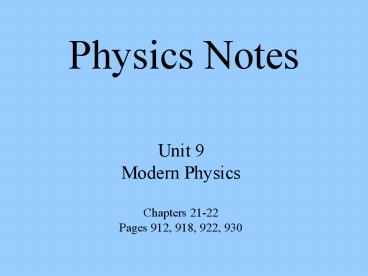Physics Notes - PowerPoint PPT Presentation
1 / 24
Title: Physics Notes
1
Physics Notes
- Unit 9
- Modern Physics
- Chapters 21-22
- Pages 912, 918, 922, 930
2
- Does light travel as a wave?
- What evidence do we have?
- Does light travel as a particle?
- What evidence do we have?
- Wave Particle Duality
3
- Blackbody Radiation
- As the temperature increases the electromagnetic
radiation emitted by bodies is strongest at
higher frequencies - http//physics.bu.edu/duffy/semester2/c34_blackbo
dy.html - http//phet.colorado.edu/new/simulations/sims.php?
simBlackbody_Spectrum - file//bcsdapp/examview/PhET-1.0/new/simulations/
sims8eab.html?simBlackbody_Spectrum
4
- Atomic Theory
- Thomson (1897) - atom is divisible.
- -plum pudding model
- Rutherford (1908)
- Atoms had a concentrated
- nucleus but are comprised
- mostly empty space
- -gold foil experiment
5
- Atomic Theory (cont)
- Bohr (1913) - Electrons move in definite orbits
around the nucleus. - Each orbital is a different energy level.
- http//www.upscale.utoronto.ca/PVB/Harrison/BohrMo
del/Flash/BohrModel.html - http//lectureonline.cl.msu.edu/mmp/kap29/Bohr/ap
p.htm - Bohr developed his model of the atom based on
spectral emission and absorption patterns.
6
- Study of Spectroscopy (using a spectrometer)
- Quantum - fixed amount
- Photons quantized energy in the form of light
- Review
- Electronvolt (eV)
- Potential Difference (V)
7
- Characteristic patterns resulted from the
quantized nature of - light. Certain wavelengths of light are produced
as electrons - change orbitals.
- Ephoton Ei Ef
- Plancks Quantum Hypothesis
- Energy distributed among the oscillating
electric charges of the molecules is not
continuous, it consisted of finite number of very
small discrete amounts, related to frequency - Ephoton hf
- h Plancks Constant 6.63 x 10-34 Js
- or (since c lf) E hc/l
8
pp
9
Production of an Emission Spectrum
10
(No Transcript)
11
Where are the photons for the other electron
transitions?
12
- Applications of Spectroscopy
- Light spectra can shift due to the relative
motion between the observer and the light source
Doppler Effect
13
- Photoelectric Effect
- When light shines on a metal surface, electrons
are emitted - KE hf - hf0
- hf0 work function, energy needed to remove the
e- - http//physics.berea.edu/king/Teaching/ModPhys/QM
/Photoelectric/Photoelectric.html - http//phet.colorado.edu/new/simulations/sims.php?
simPhotoelectric_Effect - file//bcsdapp/examview/PhET-1.0/new/simulations/
sims1db0.html?simPhotoelectric_Effect - Energy of the electron based on frequency, not
the intensity of the light. - Disproves a classical model.
- Einstein won a Nobel Prize (1921) for this
theory. - Based on the work of Planck.
- Tested and proven by Millikan.
14
- Quantum Mechanics the study that unifies the
wave-particle duality into a consistent theory - Other Significant Works
- Compton Effect Photon collides with an electron
and changes l (energy) - http//www.student.nada.kth.se/f93-jhu/phys_sim/
compton/Compton.htm
15
- Broglie Waves all matter has both wave and
particle properties (l h/p h/mv) - Heisenberg Uncertainty Principle momentum and
position of an electron cannot be determined
concurrently
16
- Nuclear Physics
- Einstein's famous equation that relates mass to
energy - E mc2
17
The Mass Deficit of the Nucleus and Nuclear
Binding Energy
Example 3 The Binding Energy of the Helium
Nucleus Revisited The atomic mass of helium is
4.0026u and the atomic mass of hydrogen is
1.0078u. Using atomic mass units, instead of
kilograms, obtain the binding energy of the
helium nucleus.
18
- Compare mass of He to its components
How is this mass accounted for? Binding Energy E
mc2 E 4.53981 x 10-12 J 28.30 MeV (1eV
1.6 x 10-19 J)
19
- The 4 Fundamental Forces
- (in order of strength)
- Strong Nuclear Holds nucleus together
- (short range)
- 2. Electromagnetic
- Electrostatic Forces (ie Coulombs Law)
- Magnetic Forces
- 3. Weak Nuclear binds subatomic particles
(short range) - 4. Gravity
- (ie Newtons Law of Universal Gravitation)
20
- Nuclear Decay Unstable nuclei break down
- 3 Types of Radiation
- Alpha Particles Helium nucleus (2P, 2N)
- Beta Particles Nuclear Electron
- Gamma Ray electromagnetic radiation
- Fission - splits a nucleus
- Fusion - small particle are combined
21
(No Transcript)
22
- The Standard Model
- The Building Blocks of Matter
- Quarks Make up Protons and Neutrons
- Leptons Most famous is the electron
- For every particle there is a corresponding
antiparticle with an opposite charge - Great Web Site http//particleadventure.org/parti
cleadventure/index.html
23
(No Transcript)
24
- The End
- Good Luck































